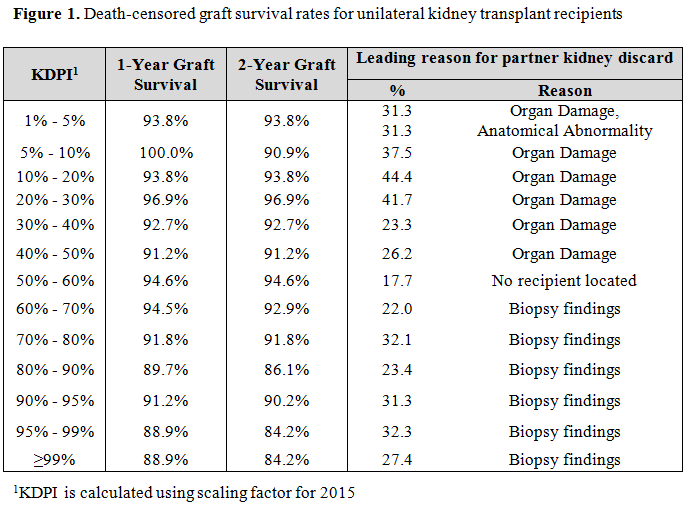Characteristics and Performance of Unilateral Deceased Donor Kidney Transplants.
1Columbia Univ, New York, NY
2Emory Univ, Atlanta, GA
Meeting: 2017 American Transplant Congress
Abstract number: C43
Keywords: Kidney transplantation, Outcome
Session Information
Session Name: Poster Session C: Deceased Donor Issues II: DCD, DGF, AKI, En-Bloc
Session Type: Poster Session
Date: Monday, May 1, 2017
Session Time: 6:00pm-7:00pm
 Presentation Time: 6:00pm-7:00pm
Presentation Time: 6:00pm-7:00pm
Location: Hall D1
Purpose:
The fraction of kidneys procured for transplant that are discarded is rising in the United States. Identifying donors from whom only one kidney was discarded allows us to control for donor traits and better assess reasons for organ discard.
Methods:
We conducted a retrospective cohort study using UNOS STAR file data. Unilateral pairs were defined as kidney pairs from a single donor from whom one kidney was discarded (unilateral discard) but the other was transplanted (unilateral transplant). We identified 102,684 donors from 2000-2015 from whom both kidneys were procured, then excluded kidneys missing transplant-specific data (1,116) and donors whose kidneys were both discarded (13,771) or transplanted (81,040), yielding 7,315 unilateral pairs for our analysis. Organ quality was estimated using the Kidney Donor Risk Index (KDRI) and Kidney Donor Profile Index (KDPI).
Results:
Compared to bilateral donors, unilateral donors (n=7,315) were significantly older (mean age 48±16yrs v 36±16yrs); more likely to have hypertension (47% v 23%), diabetes (13% v 5%), hepatitis C (12.5% v 1.8%), or death from stroke (50% v 33%); or meet CDC “high risk” criteria (12% v 9%). Unilateral donors also had higher terminal creatinine (mean 1.3±1.1 v 1.1±0.9mg/dL), KDPI (median 73± 37% v 40±44%), and likelihood of having a biopsy performed (69% v 35%). Most unilateral discards were due to factors that would be expected to be similar in both kidneys from a given donor: biopsy findings (23%), no interested recipient (14%), function (13%), and history (8%). While organ damage (11%), anatomic abnormality (14%), or extended ischemia (6%) accounted for only one third of the discards overall, they were the most common reasons for discard for lower KDPI donors. One- and 2-year unilateral transplant graft survival was >90% for almost all KDPI categories. Conclusions:
Conclusions:
A large number of discarded kidneys were procured from donors whose contralateral kidneys were transplanted with excellent post-transplant outcomes, suggesting that, at least in the case of factors that would be expected to impact both kidneys equally, the discards may have been inappropriate.
CITATION INFORMATION: Husain S, Lee S, Mohan S, Pastan S, Patzer R, Chiles M. Characteristics and Performance of Unilateral Deceased Donor Kidney Transplants. Am J Transplant. 2017;17 (suppl 3).
To cite this abstract in AMA style:
Husain S, Lee S, Mohan S, Pastan S, Patzer R, Chiles M. Characteristics and Performance of Unilateral Deceased Donor Kidney Transplants. [abstract]. Am J Transplant. 2017; 17 (suppl 3). https://atcmeetingabstracts.com/abstract/characteristics-and-performance-of-unilateral-deceased-donor-kidney-transplants/. Accessed December 18, 2025.« Back to 2017 American Transplant Congress
